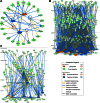E-cigarette use results in suppression of immune and inflammatory-response genes in nasal epithelial cells similar to cigarette smoke
- PMID: 27288488
- PMCID: PMC4967187
- DOI: 10.1152/ajplung.00170.2016
E-cigarette use results in suppression of immune and inflammatory-response genes in nasal epithelial cells similar to cigarette smoke
Abstract
Exposure to cigarette smoke is known to result in impaired host defense responses and immune suppressive effects. However, the effects of new and emerging tobacco products, such as e-cigarettes, on the immune status of the respiratory epithelium are largely unknown. We conducted a clinical study collecting superficial nasal scrape biopsies, nasal lavage, urine, and serum from nonsmokers, cigarette smokers, and e-cigarette users and assessed them for changes in immune gene expression profiles. Smoking status was determined based on a smoking history and a 3- to 4-wk smoking diary and confirmed using serum cotinine and urine 4-(methylnitrosamino)-1-(3-pyridyl)-1-butanol (NNAL) levels. Total RNA from nasal scrape biopsies was analyzed using the nCounter Human Immunology v2 Expression panel. Smoking cigarettes or vaping e-cigarettes resulted in decreased expression of immune-related genes. All genes with decreased expression in cigarette smokers (n = 53) were also decreased in e-cigarette smokers. Additionally, vaping e-cigarettes was associated with suppression of a large number of unique genes (n = 305). Furthermore, the e-cigarette users showed a greater suppression of genes common with those changed in cigarette smokers. This was particularly apparent for suppressed expression of transcription factors, such as EGR1, which was functionally associated with decreased expression of 5 target genes in cigarette smokers and 18 target genes in e-cigarette users. Taken together, these data indicate that vaping e-cigarettes is associated with decreased expression of a large number of immune-related genes, which are consistent with immune suppression at the level of the nasal mucosa.
Keywords: e-cigarettes; gene expression; nasal epithelial cells.
Copyright © 2016 the American Physiological Society.
Figures






Similar articles
-
Electronic-Cigarette Use Alters Nasal Mucosal Immune Response to Live-attenuated Influenza Virus. A Clinical Trial.Am J Respir Cell Mol Biol. 2021 Jan;64(1):126-137. doi: 10.1165/rcmb.2020-0164OC. Am J Respir Cell Mol Biol. 2021. PMID: 33095645 Free PMC article.
-
Effect of Pod e-Cigarettes vs Cigarettes on Carcinogen Exposure Among African American and Latinx Smokers: A Randomized Clinical Trial.JAMA Netw Open. 2020 Nov 2;3(11):e2026324. doi: 10.1001/jamanetworkopen.2020.26324. JAMA Netw Open. 2020. PMID: 33206193 Free PMC article. Clinical Trial.
-
Dual Users Compared to Smokers: Demographics, Dependence, and Biomarkers.Nicotine Tob Res. 2019 Aug 19;21(9):1279-1284. doi: 10.1093/ntr/nty231. Nicotine Tob Res. 2019. PMID: 30365010 Free PMC article.
-
Vaping versus Smoking: A Quest for Efficacy and Safety of E-cigarette.Curr Drug Saf. 2018;13(2):92-101. doi: 10.2174/1574886313666180227110556. Curr Drug Saf. 2018. PMID: 29485005 Review.
-
Effects of Electronic Cigarettes on Periodontal Health: A Systematic Review and Meta-Analysis.Int Dent J. 2025 Jun;75(3):2014-2024. doi: 10.1016/j.identj.2024.12.036. Epub 2025 Jan 24. Int Dent J. 2025. PMID: 39863518 Free PMC article.
Cited by
-
Untargeted Metabolomics to Characterize the Urinary Chemical Landscape of E-Cigarette Users.Chem Res Toxicol. 2023 Apr 17;36(4):630-642. doi: 10.1021/acs.chemrestox.2c00346. Epub 2023 Mar 13. Chem Res Toxicol. 2023. PMID: 36912507 Free PMC article.
-
Microglia Activation and Gene Expression Alteration of Neurotrophins in the Hippocampus Following Early-Life Exposure to E-Cigarette Aerosols in a Murine Model.Toxicol Sci. 2018 Mar 1;162(1):276-286. doi: 10.1093/toxsci/kfx257. Toxicol Sci. 2018. PMID: 29161446 Free PMC article.
-
Electronic Cigarette Users' Perspective on the COVID-19 Pandemic: Observational Study Using Twitter Data.JMIR Public Health Surveill. 2021 Jan 5;7(1):e24859. doi: 10.2196/24859. JMIR Public Health Surveill. 2021. PMID: 33347422 Free PMC article.
-
Exosomal microRNAs are novel circulating biomarkers in cigarette, waterpipe smokers, E-cigarette users and dual smokers.BMC Med Genomics. 2020 Sep 10;13(1):128. doi: 10.1186/s12920-020-00748-3. BMC Med Genomics. 2020. PMID: 32912198 Free PMC article.
-
Acute vaping in a golden Syrian hamster causes inflammatory response transcriptomic changes.Am J Physiol Lung Cell Mol Physiol. 2022 Nov 1;323(5):L525-L535. doi: 10.1152/ajplung.00162.2022. Epub 2022 Aug 30. Am J Physiol Lung Cell Mol Physiol. 2022. PMID: 36041220 Free PMC article.
References
-
- Aligne CA, Stoddard JJ. Tobacco and children. An economic evaluation of the medical effects of parental smoking. Arch Pediatr Adolesc Med 151: 648–653, 1997. - PubMed
-
- Allen JG, Flanigan SS, LeBlanc M, Vallarino J, MacNaughton P, Stewart JH, Christiani DC. Flavoring chemicals in E-cigarettes: diacetyl, 2,3-pentanedione, and acetoin in a sample of 51 products, including fruit-, candy-, and cocktail-flavored E-cigarettes. Environ Health Perspect 124: 733–739, 2016. - PMC - PubMed
-
- Campbell JD, McDonough JE, Zeskind JE, Hackett TL, Pechkovsky DV, Brandsma CA, Suzuki M, Gosselink JV, Liu G, Alekseyev YO, Xiao J, Zhang X, Hayashi S, Cooper JD, Timens W, Postma DS, Knight DA, Lenburg ME, Hogg JC, Spira A. A gene expression signature of emphysema-related lung destruction and its reversal by the tripeptide GHK. Genome Med 4: 67, 2012. - PMC - PubMed
-
- Centers for Disease Control.Emerging tobacco products gaining popularity among youth. 2013. http://www.cdc.gov/media/releases/2013/p1114-emerging-tobacco-products.html [06/June/2016].
Publication types
MeSH terms
Substances
Grants and funding
LinkOut - more resources
Full Text Sources
Other Literature Sources

